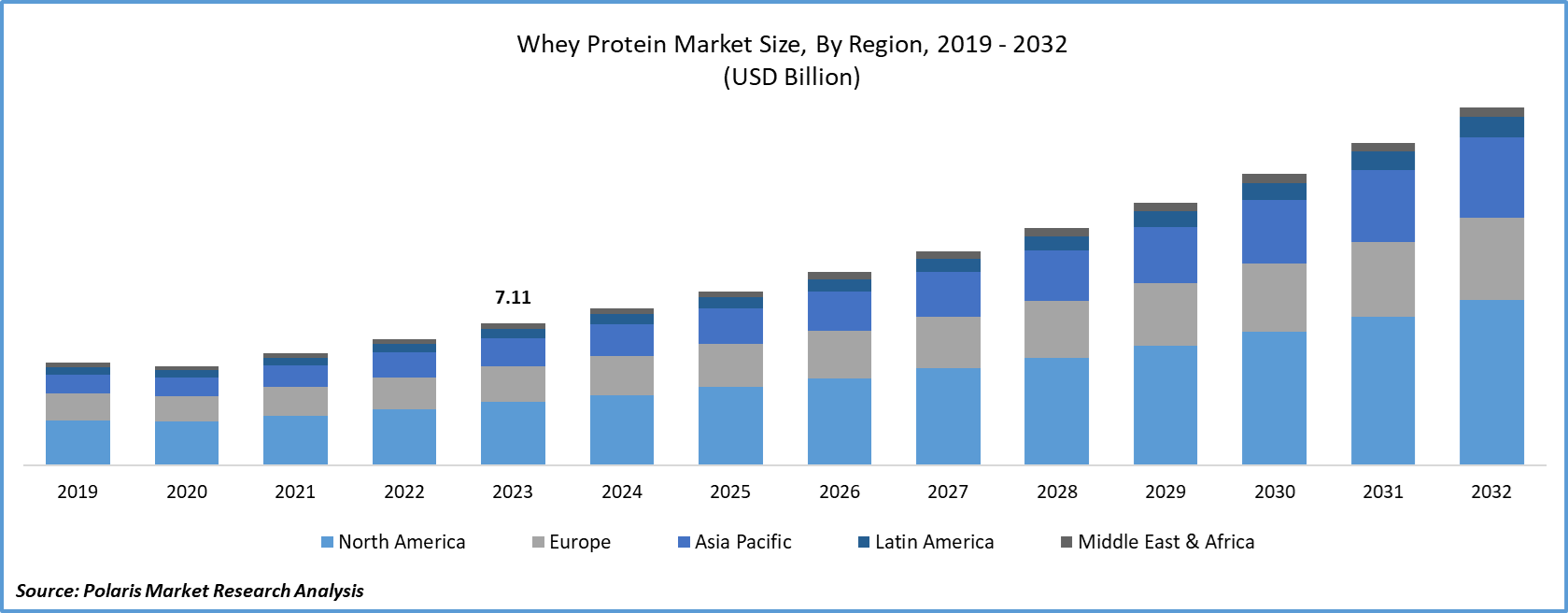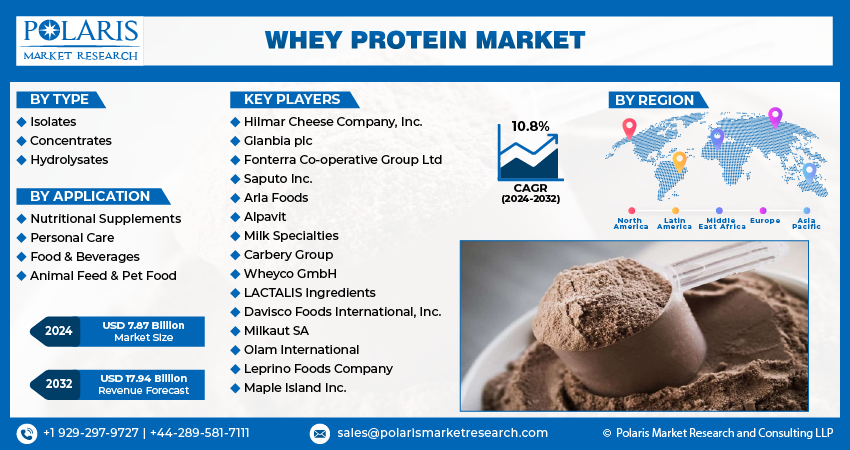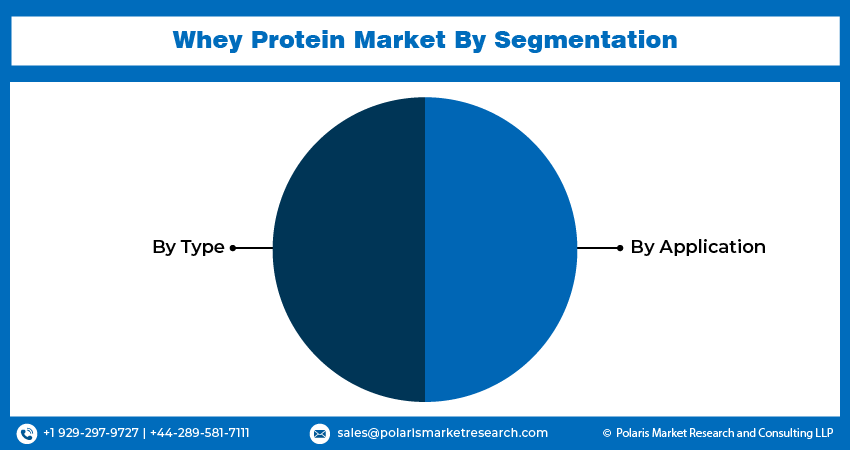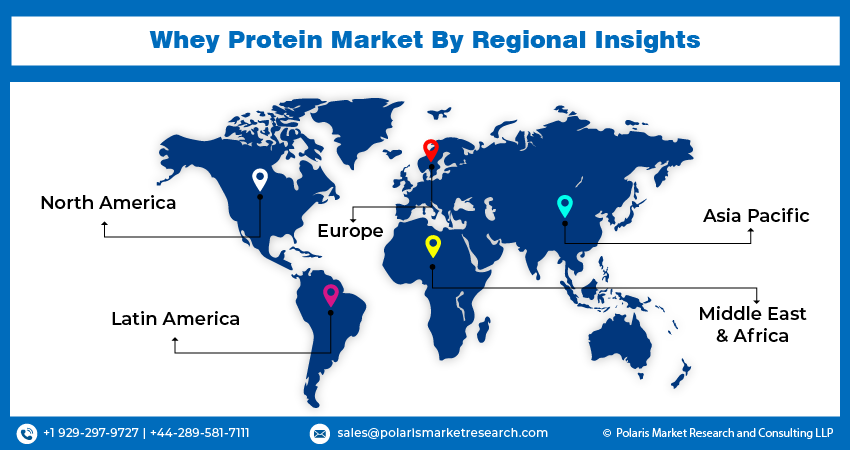
Whey Protein Market Share, Size, Trends, Industry Analysis Report, By Type (Isolates, Concentrates, Hydrolysates); By Application (Nutritional Supplements, Personal Care, Food & Beverages, Animal Feed & Pet Food); By Regions; Segment Forecast, 2024 - 2032
- Published Date:Jan-2024
- Pages: 116
- Format: PDF
- Report ID: PM1860
- Base Year: 2023
- Historical Data: 2019-2022
Report Outlook
The global whey protein market size was valued at USD 7.11 billion in 2023. The market is anticipated to grow from USD 7.87 billion in 2024 to USD 17.94 billion by 2032, exhibiting the CAGR of 10.8% during the forecast period.
The key factors responsible for the market growth for whey protein include an increase in the incidence of chronic conditions among millennials due to rapidly changing lifestyles and busier day-to-day activities, higher adoption of protein-rich diets among the younger generation, growing consumer shift towards natural foods, and innovations in the food processing industry.
Product innovations, technological advancements, and the introduction of regulatory policies have been detailed in the report to enable businesses to make more informed decisions. Furthermore, the impact of the COVID-19 pandemic on the whey protein market demand has been examined in the study. The report is a must-read for anyone looking to develop effective strategies and stay ahead of the curve.
 Know more about this report: request for sample pages
Know more about this report: request for sample pages
The product is mostly preferred by athletes and sports personalities, owing to its strong amino content, easier digestible ratio, and wide availability. A rise in demand for nutritional supplements is projected to offer lucrative growth opportunities for whey protein over the forecast period.
According to the analysis/survey done by the U.S.-based Institute of Food Technologists, found that around 55 percent of consumers in the country believed that high protein content played important role in product purchasing. Moreover, around half of the country’s obese people want to lose weight, owing to serious life concerns of being obese and the onset of chronic conditions.

Report Segmentation
The market is primarily segmented on the basis of type, application, and region.
|
By Type |
By Application |
By Region |
|
|
|
Know more about this report: request for sample pages
Insight by Type
The whey protein concentrates market segment accounted to hold the largest share in the global market, in 2020. This is a type of whey protein that remains soluble in the whey after the casein precipitation at the pH of 4.6 and temperature of around 20°C. These are a heterogeneous grouping of different kinds of proteins and mostly contain lipids, lactose, and minerals.
Whey protein concentrates find their application in dairy desserts, yogurts, and nutritional drinks and beverages and are employed as protein fortification in infant and nutritional foods. They have excellent gelling properties, and insoluble in water. Property is extremely useful in the sports nutrition and meat processing market.
Whey protein hydrolysate is anticipated to register the highest market growth over the study period. It exhibits antioxidant, prebiotic, hypertensive, and antimicrobial properties and is mostly used in the infant, clinical, and sports nutrition industry.
However, these proteins are more expensive compared to others, hence most whey supplement manufacturers use a small proportion in their respective formulas. Its wide applicability in bakery products as an ingredient in diabetic foods, low-fat content diets, and fortified protein-rich beverages, and favorable regulatory support in the U.S. is likely to drive the segment market growth over the coming years.
Insight by Application
The food & beverage segment of whey protein market accounted for the largest revenue share in 2020. Whey proteins are largely preferred in the bakery and dairy industry, owing to their ability to foam, emulsify, thicken products. These also increase the gelation, water-binding capabilities, solubility, and nutritional value in the food industry.
The whey protein market has witnessed several developments in the beverage and confectionery space, for instance, in February 2019, Arla foods introduced a new product “whey protein medical beverage” targeted for requiring clinical nutrition in low volumes. Such developments in the beverage space are expected to fuel product growth in the beverage segment over the study period.

In the cosmetics & personal care market it is used to manufacture hair conditioners, dyes, color, moisturizing creams, wave sets, and face and eye care products. The demand for whey proteins is likely to witness moderate growth, owing to its skin hydrating, conditioning, and hair conditioning properties.
Moreover, a shift in consumer’s preference towards herbal personal care products is further going to accelerate whey protein demand in cosmetics & personal care market. Increasing disposable income of working women in developed economies like France, the U.S., Canada, and Germany is likely to foster the segment’s market growth of whey protein industry.
Geographic Overview
North America is the largest revenue contributor to the global market for whey protein and holding a major market share. The region has a huge population suffering from obesity and lifestyle-borne diseases due to changing dietary habits, and ready-to-eat processed foods, which are not essentially good for an individual’s heath. The region is witnessing transitioning phase, as it is evolved into functional foods and other supplements, which provide enormous health benefits, besides basic nutrition.
The region is projected to witness a moderate market growth over the study period, on account of the rising use of supplements with low calorie and high nutritional value. Rising consumption levels of supplements in Mexico and Canada with new product launches are projected to further favor the region’s market growth for whey protein.

Competitive Insight
Some of the key players operating in the global market for whey protein comprises Hilmar Cheese Company, Inc., Glanbia plc, Fonterra Co-operative Group Ltd, Saputo Inc., Arla Foods, Alpavit, Milk Specialties, Carbery Group, Wheyco GmbH, LACTALIS Ingredients, Davisco Foods International, Inc., Milkaut SA, Olam International, Leprino Foods Company, and Maple Island Inc.
We strive to offer our clients the finest in market research with the most reliable and accurate research findings. We use industry-standard methodologies to offer a comprehensive and authentic analysis of the whey protein market. Besides, we have stringent data-quality checks in place to enable data-driven decision-making for you.
